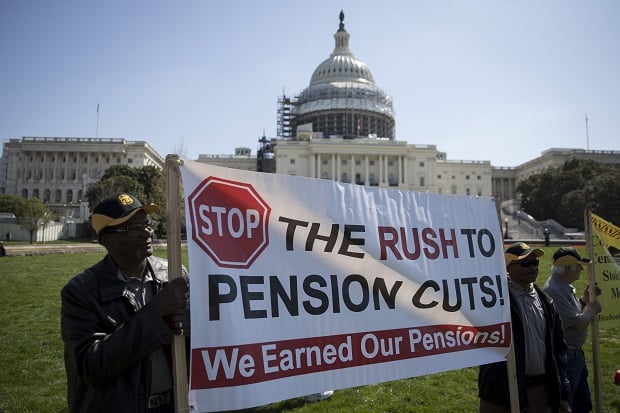 Members of the International Brotherhood of Teamsters and their supporters attend a rally outside the Capitol in Washington, D.C., U.S., on Thursday, April 14, 2016 to protest a plan by the Central States Pension Fund to reduce payments to retirees. (Photo: Drew Angerer/Bloomberg)
Members of the International Brotherhood of Teamsters and their supporters attend a rally outside the Capitol in Washington, D.C., U.S., on Thursday, April 14, 2016 to protest a plan by the Central States Pension Fund to reduce payments to retirees. (Photo: Drew Angerer/Bloomberg)
It is no secret that many multiemployer pension plans are struggling – paying out substantially more in benefits to retirees than the income they are receiving. Without legislative action, many are expected to go bankrupt in the next 5 to 15 years, leaving current retirees and active employees without the retirement income they expected. To understand where we go from here, let's first explore the history of multiemployer plans, then look at potential avenues for reform.
|How did we get here?
The Employee Retirement Income Security Act of 1974 created new fiduciary standards for trustees of multiemployer benefit plans and regulated the vesting and funding of benefits. ERISA also guaranteed certain participant benefits not funded by plan assets upon the termination of a plan.
Recommended For You
Complete your profile to continue reading and get FREE access to BenefitsPRO, part of your ALM digital membership.
Your access to unlimited BenefitsPRO content isn’t changing.
Once you are an ALM digital member, you’ll receive:
- Breaking benefits news and analysis, on-site and via our newsletters and custom alerts
- Educational webcasts, white papers, and ebooks from industry thought leaders
- Critical converage of the property casualty insurance and financial advisory markets on our other ALM sites, PropertyCasualty360 and ThinkAdvisor
Already have an account? Sign In Now
© 2025 ALM Global, LLC, All Rights Reserved. Request academic re-use from www.copyright.com. All other uses, submit a request to [email protected]. For more information visit Asset & Logo Licensing.








